headrest FIAT TALENTO 2021 Owner handbook (in English)
[x] Cancel search | Manufacturer: FIAT, Model Year: 2021, Model line: TALENTO, Model: FIAT TALENTO 2021Pages: 236, PDF Size: 4.86 MB
Page 14 of 236
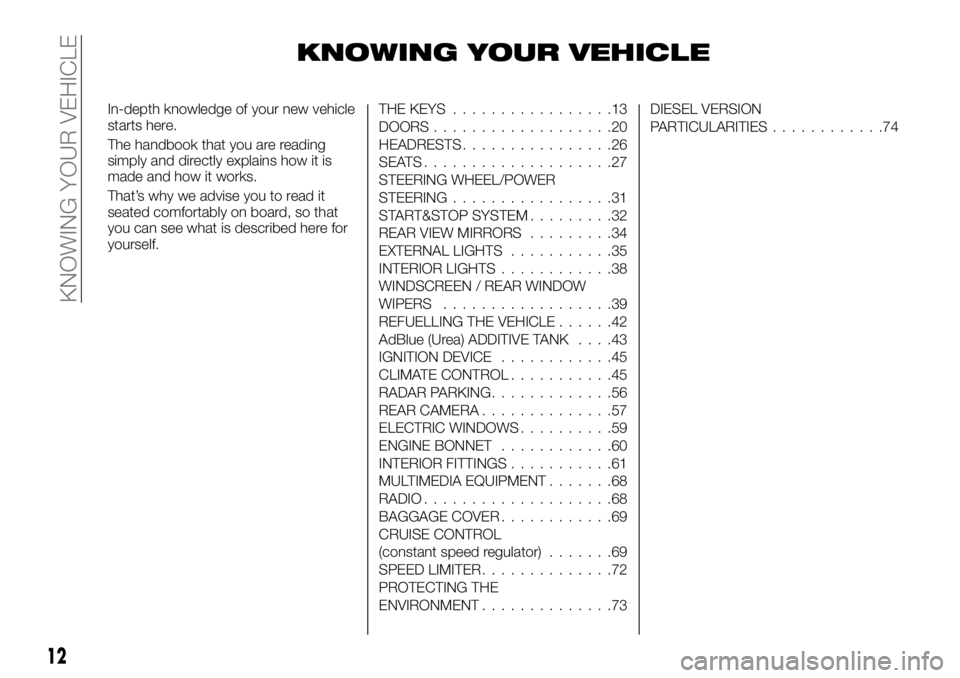
KNOWING YOUR VEHICLE
In-depth knowledge of your new vehicle
starts here.
The handbook that you are reading
simply and directly explains how it is
made and how it works.
That’s why we advise you to read it
seated comfortably on board, so that
you can see what is described here for
yourself.THE KEYS.................13
DOORS...................20
HEADRESTS................26
SEATS....................27
STEERING WHEEL/POWER
STEERING.................31
START&STOP SYSTEM.........32
REAR VIEW MIRRORS.........34
EXTERNAL LIGHTS...........35
INTERIOR LIGHTS............38
WINDSCREEN / REAR WINDOW
WIPERS..................39
REFUELLING THE VEHICLE......42
AdBlue (Urea) ADDITIVE TANK....43
IGNITION DEVICE............45
CLIMATE CONTROL...........45
RADAR PARKING.............56
REAR CAMERA..............57
ELECTRIC WINDOWS..........59
ENGINE BONNET............60
INTERIOR FITTINGS...........61
MULTIMEDIA EQUIPMENT.......68
RADIO....................68
BAGGAGE COVER............69
CRUISE CONTROL
(constant speed regulator).......69
SPEED LIMITER..............72
PROTECTING THE
ENVIRONMENT..............73DIESEL VERSION
PARTICULARITIES............74
12
KNOWING YOUR VEHICLE
Page 28 of 236
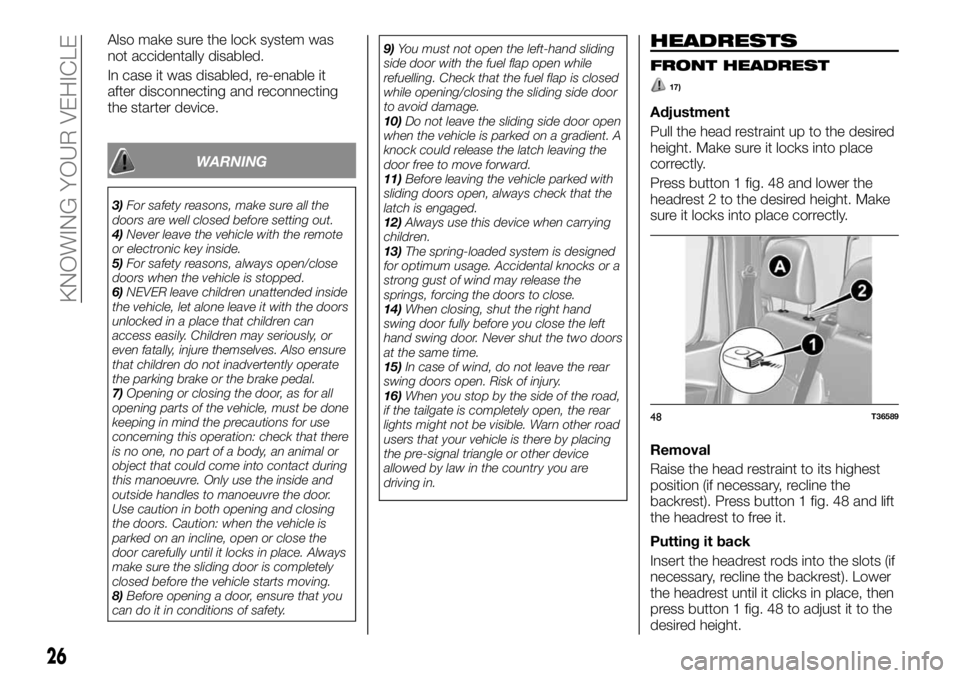
Also make sure the lock system was
not accidentally disabled.
In case it was disabled, re-enable it
after disconnecting and reconnecting
the starter device.
WARNING
3)For safety reasons, make sure all the
doors are well closed before setting out.
4)Never leave the vehicle with the remote
or electronic key inside.
5)For safety reasons, always open/close
doors when the vehicle is stopped.
6)NEVER leave children unattended inside
the vehicle, let alone leave it with the doors
unlocked in a place that children can
access easily. Children may seriously, or
even fatally, injure themselves. Also ensure
that children do not inadvertently operate
the parking brake or the brake pedal.
7)Opening or closing the door, as for all
opening parts of the vehicle, must be done
keeping in mind the precautions for use
concerning this operation: check that there
is no one, no part of a body, an animal or
object that could come into contact during
this manoeuvre. Only use the inside and
outside handles to manoeuvre the door.
Use caution in both opening and closing
the doors. Caution: when the vehicle is
parked on an incline, open or close the
door carefully until it locks in place. Always
make sure the sliding door is completely
closed before the vehicle starts moving.
8)Before opening a door, ensure that you
can do it in conditions of safety.9)You must not open the left-hand sliding
side door with the fuel flap open while
refuelling. Check that the fuel flap is closed
while opening/closing the sliding side door
to avoid damage.
10)Do not leave the sliding side door open
when the vehicle is parked on a gradient. A
knock could release the latch leaving the
door free to move forward.
11)Before leaving the vehicle parked with
sliding doors open, always check that the
latch is engaged.
12)Always use this device when carrying
children.
13)The spring-loaded system is designed
for optimum usage. Accidental knocks or a
strong gust of wind may release the
springs, forcing the doors to close.
14)When closing, shut the right hand
swing door fully before you close the left
hand swing door. Never shut the two doors
at the same time.
15)In case of wind, do not leave the rear
swing doors open. Risk of injury.
16)When you stop by the side of the road,
if the tailgate is completely open, the rear
lights might not be visible. Warn other road
users that your vehicle is there by placing
the pre-signal triangle or other device
allowed by law in the country you are
driving in.
HEADRESTS
FRONT HEADREST
17)
Adjustment
Pull the head restraint up to the desired
height. Make sure it locks into place
correctly.
Press button 1 fig. 48 and lower the
headrest 2 to the desired height. Make
sure it locks into place correctly.
Removal
Raise the head restraint to its highest
position (if necessary, recline the
backrest). Press button 1 fig. 48 and lift
the headrest to free it.
Putting it back
Insert the headrest rods into the slots (if
necessary, recline the backrest). Lower
the headrest until it clicks in place, then
press button 1 fig. 48 to adjust it to the
desired height.
48T36589
26
KNOWING YOUR VEHICLE
Page 29 of 236
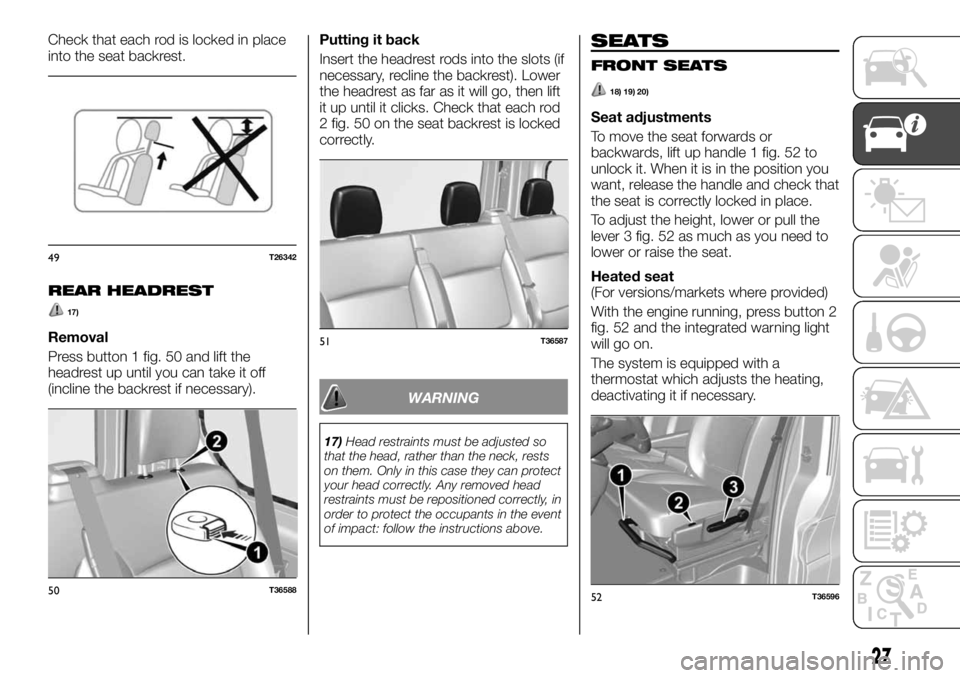
Check that each rod is locked in place
into the seat backrest.
REAR HEADREST
17)
Removal
Press button 1 fig. 50 and lift the
headrest up until you can take it off
(incline the backrest if necessary).Putting it back
Insert the headrest rods into the slots (if
necessary, recline the backrest). Lower
the headrest as far as it will go, then lift
it up until it clicks. Check that each rod
2 fig. 50 on the seat backrest is locked
correctly.
WARNING
17)Head restraints must be adjusted so
that the head, rather than the neck, rests
on them. Only in this case they can protect
your head correctly. Any removed head
restraints must be repositioned correctly, in
order to protect the occupants in the event
of impact: follow the instructions above.
SEATS
FRONT SEATS
18) 19) 20)
Seat adjustments
To move the seat forwards or
backwards, lift up handle 1 fig. 52 to
unlock it. When it is in the position you
want, release the handle and check that
the seat is correctly locked in place.
To adjust the height, lower or pull the
lever 3 fig. 52 as much as you need to
lower or raise the seat.
Heated seat
(For versions/markets where provided)
With the engine running, press button 2
fig. 52 and the integrated warning light
will go on.
The system is equipped with a
thermostat which adjusts the heating,
deactivating it if necessary.
49T26342
50T36588
51T36587
52T36596
27
Page 95 of 236
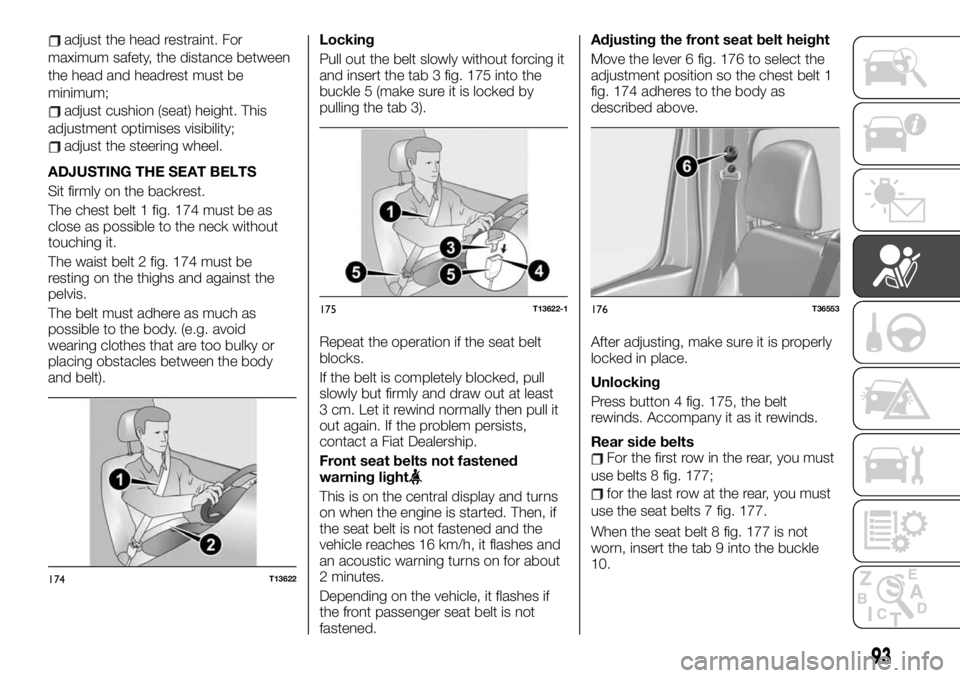
adjust the head restraint. For
maximum safety, the distance between
the head and headrest must be
minimum;
adjust cushion (seat) height. This
adjustment optimises visibility;
adjust the steering wheel.
ADJUSTING THE SEAT BELTS
Sit firmly on the backrest.
The chest belt 1 fig. 174 must be as
close as possible to the neck without
touching it.
The waist belt 2 fig. 174 must be
resting on the thighs and against the
pelvis.
The belt must adhere as much as
possible to the body. (e.g. avoid
wearing clothes that are too bulky or
placing obstacles between the body
and belt).Locking
Pull out the belt slowly without forcing it
and insert the tab 3 fig. 175 into the
buckle 5 (make sure it is locked by
pulling the tab 3).
Repeat the operation if the seat belt
blocks.
If the belt is completely blocked, pull
slowly but firmly and draw out at least
3 cm. Let it rewind normally then pull it
out again. If the problem persists,
contact a Fiat Dealership.
Front seat belts not fastened
warning light
This is on the central display and turns
on when the engine is started. Then, if
the seat belt is not fastened and the
vehicle reaches 16 km/h, it flashes and
an acoustic warning turns on for about
2 minutes.
Depending on the vehicle, it flashes if
the front passenger seat belt is not
fastened.Adjusting the front seat belt height
Move the lever 6 fig. 176 to select the
adjustment position so the chest belt 1
fig. 174 adheres to the body as
described above.
After adjusting, make sure it is properly
locked in place.
Unlocking
Press button 4 fig. 175, the belt
rewinds. Accompany it as it rewinds.
Rear side belts
For the first row in the rear, you must
use belts 8 fig. 177;
for the last row at the rear, you must
use the seat belts 7 fig. 177.
When the seat belt 8 fig. 177 is not
worn, insert the tab 9 into the buckle
10.
174T13622
175T13622-1176T36553
93
Page 103 of 236
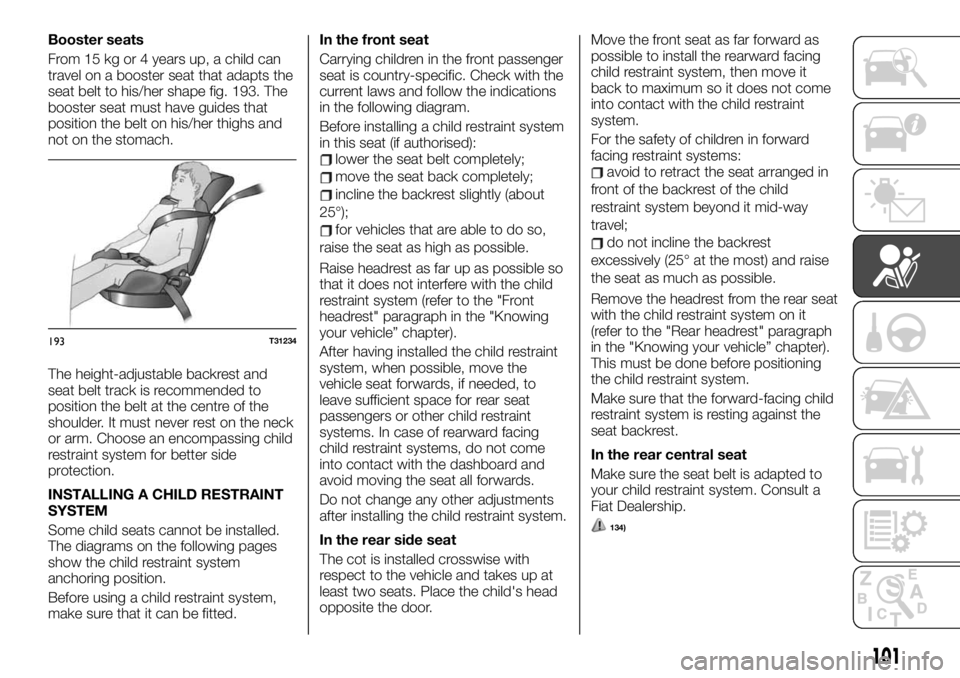
Booster seats
From 15 kg or 4 years up, a child can
travel on a booster seat that adapts the
seat belt to his/her shape fig. 193. The
booster seat must have guides that
position the belt on his/her thighs and
not on the stomach.
The height-adjustable backrest and
seat belt track is recommended to
position the belt at the centre of the
shoulder. It must never rest on the neck
or arm. Choose an encompassing child
restraint system for better side
protection.
INSTALLING A CHILD RESTRAINT
SYSTEM
Some child seats cannot be installed.
The diagrams on the following pages
show the child restraint system
anchoring position.
Before using a child restraint system,
make sure that it can be fitted.In the front seat
Carrying children in the front passenger
seat is country-specific. Check with the
current laws and follow the indications
in the following diagram.
Before installing a child restraint system
in this seat (if authorised):
lower the seat belt completely;
move the seat back completely;
incline the backrest slightly (about
25°);
for vehicles that are able to do so,
raise the seat as high as possible.
Raise headrest as far up as possible so
that it does not interfere with the child
restraint system (refer to the "Front
headrest" paragraph in the "Knowing
your vehicle” chapter).
After having installed the child restraint
system, when possible, move the
vehicle seat forwards, if needed, to
leave sufficient space for rear seat
passengers or other child restraint
systems. In case of rearward facing
child restraint systems, do not come
into contact with the dashboard and
avoid moving the seat all forwards.
Do not change any other adjustments
after installing the child restraint system.
In the rear side seat
The cot is installed crosswise with
respect to the vehicle and takes up at
least two seats. Place the child's head
opposite the door.Move the front seat as far forward as
possible to install the rearward facing
child restraint system, then move it
back to maximum so it does not come
into contact with the child restraint
system.
For the safety of children in forward
facing restraint systems:
avoid to retract the seat arranged in
front of the backrest of the child
restraint system beyond it mid-way
travel;
do not incline the backrest
excessively (25° at the most) and raise
the seat as much as possible.
Remove the headrest from the rear seat
with the child restraint system on it
(refer to the "Rear headrest" paragraph
in the "Knowing your vehicle” chapter).
This must be done before positioning
the child restraint system.
Make sure that the forward-facing child
restraint system is resting against the
seat backrest.
In the rear central seat
Make sure the seat belt is adapted to
your child restraint system. Consult a
Fiat Dealership.
134)
193T31234
101
Page 107 of 236
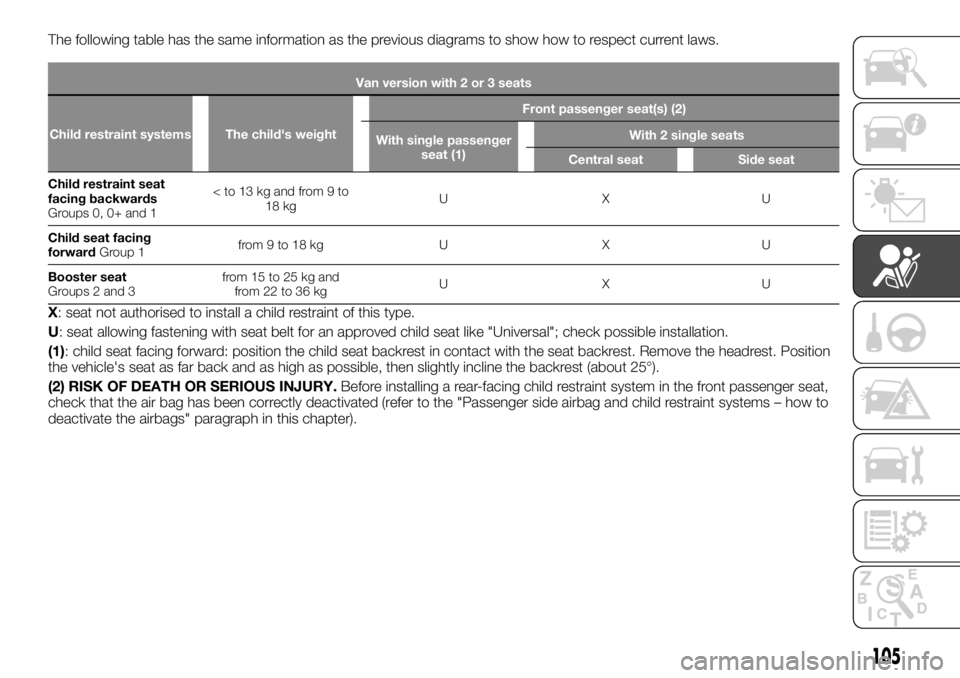
The following table has the same information as the previous diagrams to show how to respect current laws.
Van version with 2 or 3 seats
Child restraint systems The child's weightFront passenger seat(s) (2)
With single passenger
seat (1)With 2 single seats
Central seat Side seat
Child restraint seat
facing backwards
Groups 0, 0+ and 1
Child seat facing
forwardGroup 1from9to18kg U X U
Booster seatfrom 15 to 25 kg and
from 22 to 36 kgUXU
X: seat not authorised to install a child restraint of this type.
U: seat allowing fastening with seat belt for an approved child seat like "Universal"; check possible installation.
(1): child seat facing forward: position the child seat backrest in contact with the seat backrest. Remove the headrest. Position
the vehicle's seat as far back and as high as possible, then slightly incline the backrest (about 25°).
(2) RISK OF DEATH OR SERIOUS INJURY.Before installing a rear-facing child restraint system in the front passenger seat,
check that the air bag has been correctly deactivated (refer to the "Passenger side airbag and child restraint systems – how to
deactivate the airbags" paragraph in this chapter).
105
Groups 2 and 3
Page 109 of 236
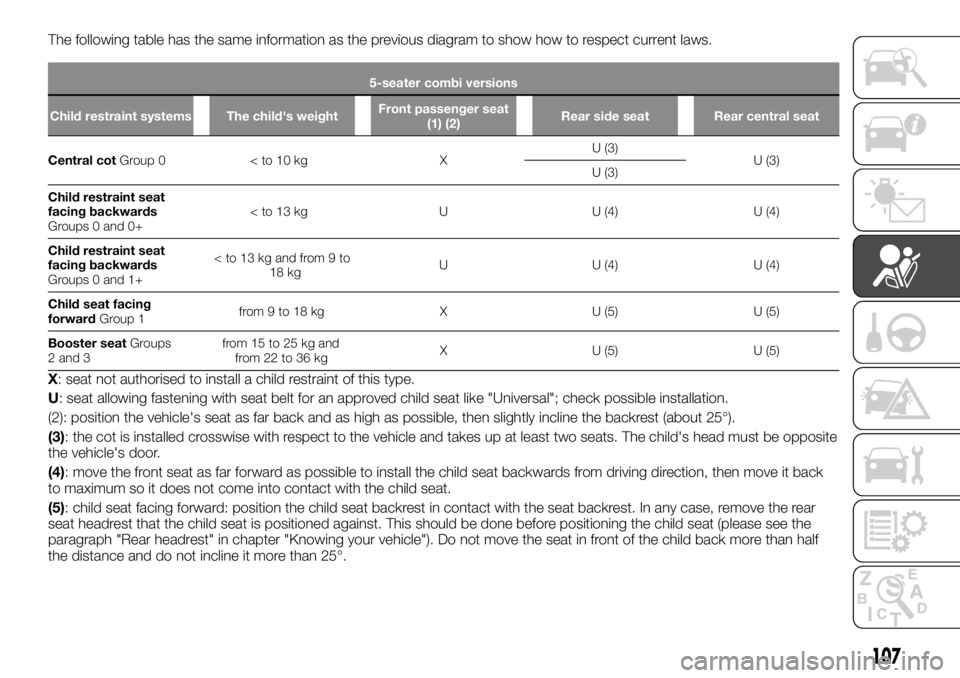
The following table has the same information as the previous diagram to show how to respect current laws.
5-seater combi versions
Child restraint systems The child's weightFront passenger seat
(1) (2)Rear side seat Rear central seat
Central cotGroup 0 < to 10 kg XU (3)
U (3)
U (3)
Child restraint seat
facing backwards
Groups 0 and 0+
facing backwards
Groups 0 and 1+
Child seat facing
forwardGroup 1from9to18kg X U(5) U(5)
Booster seatGroups
2 and 3from 15 to 25 kg and
from 22 to 36 kgX U (5) U (5)
X: seat not authorised to install a child restraint of this type.
U: seat allowing fastening with seat belt for an approved child seat like "Universal"; check possible installation.
(2): position the vehicle's seat as far back and as high as possible, then slightly incline the backrest (about 25°).
(3): the cot is installed crosswise with respect to the vehicle and takes up at least two seats. The child's head must be opposite
the vehicle's door.
(4): move the front seat as far forward as possible to install the child seat backwards from driving direction, then move it back
to maximum so it does not come into contact with the child seat.
(5): child seat facing forward: position the child seat backrest in contact with the seat backrest. In any case, remove the rear
seat headrest that the child seat is positioned against. This should be done before positioning the child seat (please see the
paragraph "Rear headrest" in chapter "Knowing your vehicle"). Do not move the seat in front of the child back more than half
the distance and do not incline it more than 25°.
107
Page 111 of 236
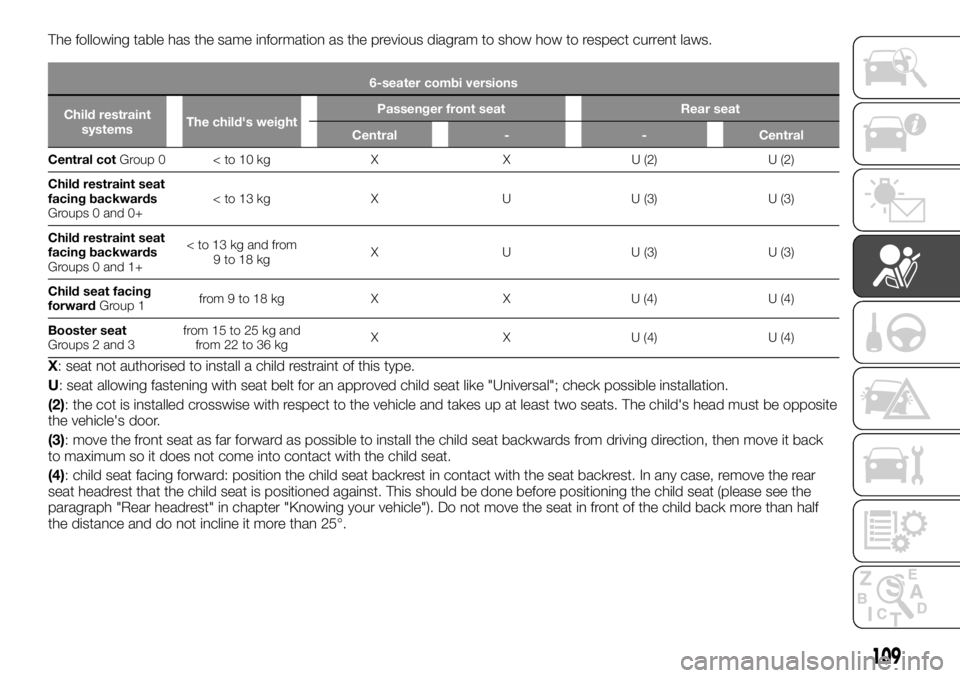
The following table has the same information as the previous diagram to show how to respect current laws.
6-seater combi versions
Child restraint
systemsThe child's weightPassenger front seat Rear seat
Central - - Central
Central cotGr
oup 0
facing backwards
Groups 0 and 0+
facing backwards
Groups 0 and 1+
Child seat facing
forwardGroup 1from 9 to 18 kg X X U (4) U (4)
Booster seat
Groups 2 and 3from 15 to 25 kg and
from 22 to 36 kgX X U (4) U (4)
X: seat not authorised to install a child restraint of this type.
U: seat allowing fastening with seat belt for an approved child seat like "Universal"; check possible installation.
(2): the cot is installed crosswise with respect to the vehicle and takes up at least two seats. The child's head must be opposite
the vehicle's door.
(3): move the front seat as far forward as possible to install the child seat backwards from driving direction, then move it back
to maximum so it does not come into contact with the child seat.
(4): child seat facing forward: position the child seat backrest in contact with the seat backrest. In any case, remove the rear
seat headrest that the child seat is positioned against. This should be done before positioning the child seat (please see the
paragraph "Rear headrest" in chapter "Knowing your vehicle"). Do not move the seat in front of the child back more than half
the distance and do not incline it more than 25°.
109
Page 113 of 236
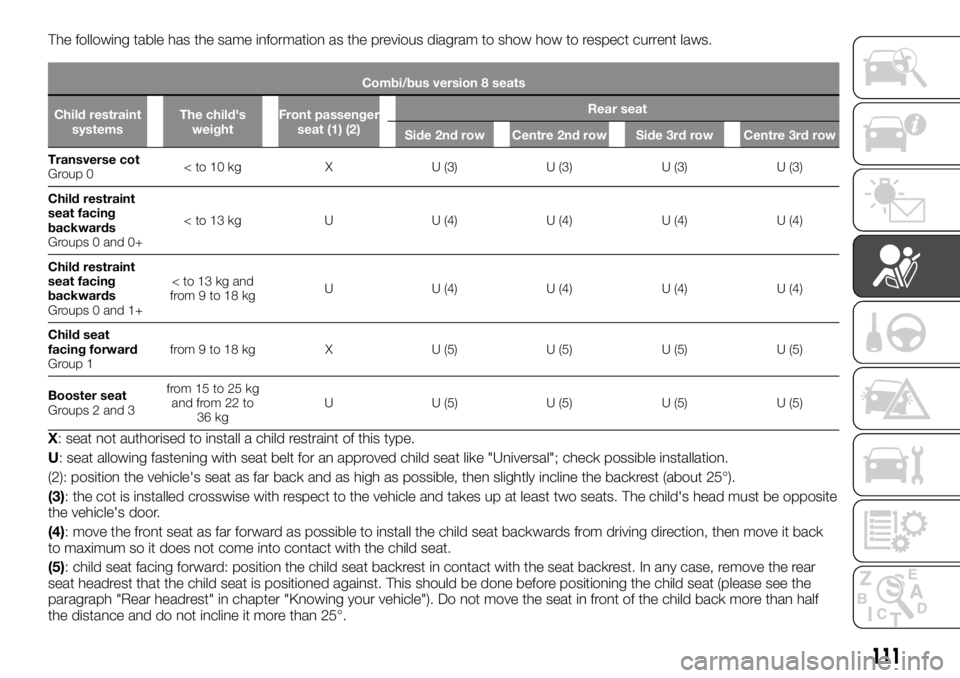
The following table has the same information as the previous diagram to show how to respect current laws.
Combi/bus version 8 seats
Child restraint
systemsThe child's
weightFront passenger
seat (1) (2)Rear seat
Side 2nd row Centre 2nd row Side 3rd row Centre 3rd row
Transverse cot
Gr
oup 0
seat facing
backwards
Groups 0 and 0+< to 13 kg U U (4) U (4) U (4) U (4)
Child restraint
seat facing
backwards
Groups 0 and 1+
Child seat
facing forward
Group 1from 9 to 18 kg X U (5) U (5) U (5) U (5)
Booster seat
Groups 2 and 3from 15 to 25 kg
and from 22 to
36 kgU U (5) U (5) U (5) U (5)
X: seat not authorised to install a child restraint of this type.
U: seat allowing fastening with seat belt for an approved child seat like "Universal"; check possible installation.
(2): position the vehicle's seat as far back and as high as possible, then slightly incline the backrest (about 25°).
(3): the cot is installed crosswise with respect to the vehicle and takes up at least two seats. The child's head must be opposite
the vehicle's door.
(4): move the front seat as far forward as possible to install the child seat backwards from driving direction, then move it back
to maximum so it does not come into contact with the child seat.
(5): child seat facing forward: position the child seat backrest in contact with the seat backrest. In any case, remove the rear
seat headrest that the child seat is positioned against. This should be done before positioning the child seat (please see the
paragraph "Rear headrest" in chapter "Knowing your vehicle"). Do not move the seat in front of the child back more than half
the distance and do not incline it more than 25°.
111
Page 115 of 236
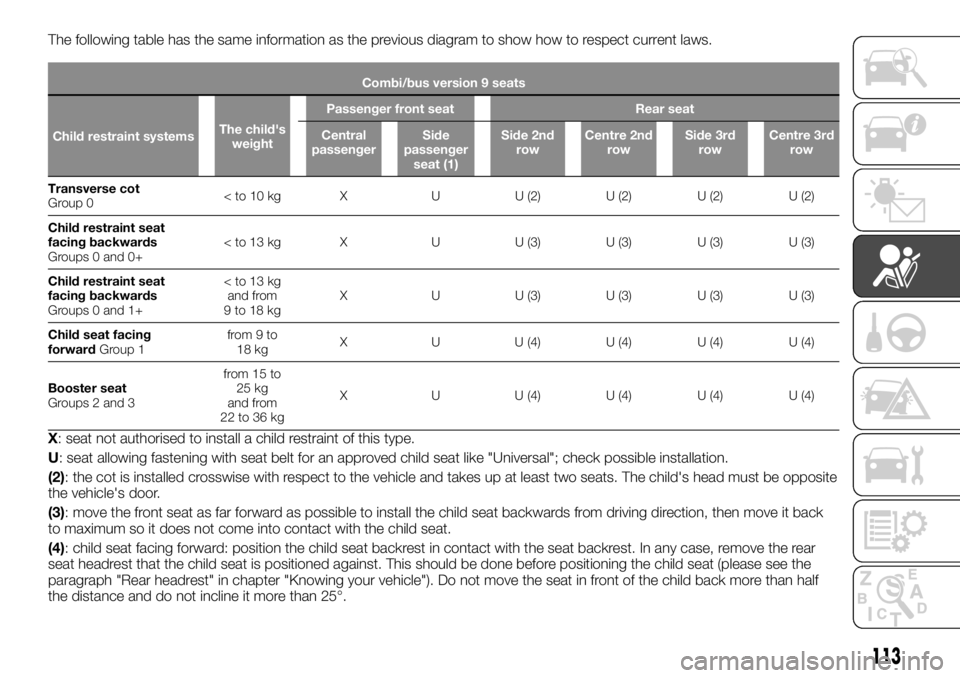
The following table has the same information as the previous diagram to show how to respect current laws.
Combi/bus version 9 seats
Child restraint systemsThe child's
weightPassenger front seat Rear seat
Central
passengerSide
passenger
seat (1)Side 2nd
rowCentre 2nd
rowSide 3rd
rowCentre 3rd
row
Transverse cot
Group 0
facing backwards
Groups 0 and 0+< to 13 kg X U U (3) U (3) U (3) U (3)
Child restraint seat
facing backwards
Groups 0 and 1+
9to18kgX U U (3) U (3) U (3) U (3)
Child seat facing
forwardGroup 1from 9 to
18 kgX U U (4) U (4) U (4) U (4)
Booster seat
Groups 2 and 3from 15 to
25 kg
and from
22 to 36 kgX U U (4) U (4) U (4) U (4)
X: seat not authorised to install a child restraint of this type.
U: seat allowing fastening with seat belt for an approved child seat like "Universal"; check possible installation.
(2): the cot is installed crosswise with respect to the vehicle and takes up at least two seats. The child's head must be opposite
the vehicle's door.
(3): move the front seat as far forward as possible to install the child seat backwards from driving direction, then move it back
to maximum so it does not come into contact with the child seat.
(4): child seat facing forward: position the child seat backrest in contact with the seat backrest. In any case, remove the rear
seat headrest that the child seat is positioned against. This should be done before positioning the child seat (please see the
paragraph "Rear headrest" in chapter "Knowing your vehicle"). Do not move the seat in front of the child back more than half
the distance and do not incline it more than 25°.
113